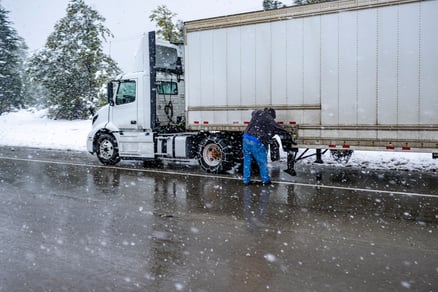
Winter can be a challenging season for the transportation industry, particularly for long-haul trucking and logistics companies. Adverse weather conditions like snow, ice, and freezing temperatures create a hazardous environment for drivers, which can result in serious accidents and costly delays. To mitigate these risks and ensure the safety of your drivers and the integrity of your cargo, it's essential to take various safety measures and prepare your fleet with the right tools and equipment.
When it comes to truck winter maintenance, your drivers serve as the primary line of defense!
Regular pre- and post-trip inspections, especially during cold conditions, play a vital role in safeguarding your fleet and your drivers! Below are some valuable tips that can help drivers prepare.
Pre-Trip Inspection:
- Check Tire Condition: Ensure that all tires are properly inflated and have adequate tread depth. Cold weather can affect tire pressure, therefore it’s essential to maintain the correct levels.
- Inspect Brakes: Verify that the brakes are in good working condition. Make sure there are no frozen brake components and check for any signs of wear or damage.
- Examine Lights: Ensure all lights, including headlights, taillights, and turn signals, are functioning correctly. Visibility is crucial during winter driving.
- Inspect the Battery: Cold weather can strain the battery. Check the battery’s condition, and connections, and ensure it's adequately charged.
- Windshield and Wipers: Verify that the windshield is free of cracks or chips. Check wiper blades and washer fluid to ensure clear visibility in snowy or icy conditions.
- Fluid Levels: Ensure all fluid levels are appropriate, including engine oil, coolant, and washer fluid. Cold weather can increase the demand for engine oil and antifreeze.
- Heating System: Test the heating system to ensure it’s working correctly. Drivers must stay warm during the cold weather, and a functioning heater is essential.
- Inspect Belts and Hoses: Examine belts and hoses for signs of wear or damage. Cold temperatures can make them more prone to cracking or failure.
Post-Trip Inspection:
- Clean the Truck: Remove any snow, ice, and road salt from the truck to prevent corrosion and maintain visibility. Make sure that ADAS systems are free from road grime, snow, and ice.
- Check for Damage: Look for any damage caused by the harsh weather, such as cracked windshields or dented body panels. Report any issues promptly.
- Verify Fuel Levels: Ensure the fuel tank is adequately filled to prevent freezing and gelling of diesel fuel. For temperatures below 0 degrees F consider using an anti-gelling additive.
- Monitor Tire Pressure: Recheck tire pressure after the trip, as it can change in extreme cold. Inflate or deflate as necessary.
- Refill Fluids: Top up fluids, if necessary, especially windshield washer fluid, which can be used up quickly in snowy conditions.
- Charge the Battery: If the truck has been running for an extended period, the alternator should have charged the battery. Verify the battery’s condition and charge if needed.
- Check for Leaks: Inspect the truck for any leaks that may have developed during the trip due to temperature fluctuations.
- Replenish Emergency Supplies: Make sure all emergency supplies are replenished, including warm clothing, blankets, and food in case of unexpected delays.
Providing your drivers with these essential tips and encouraging them to follow these guidelines diligently can help ensure their safety, other motorists' safety, and the efficiency of your fleet during the winter months.


%20Cropped.jpg)



